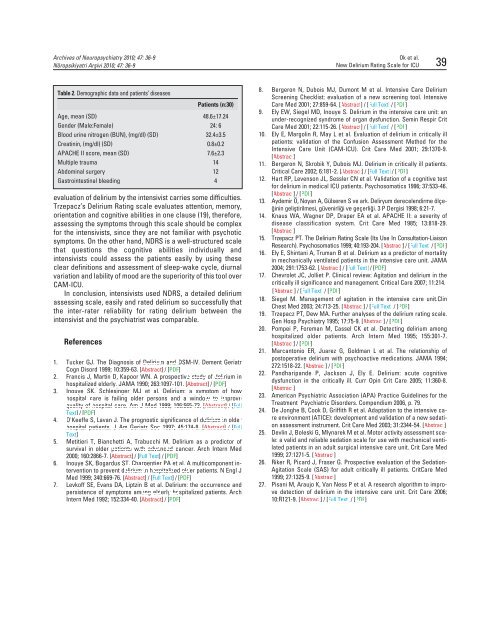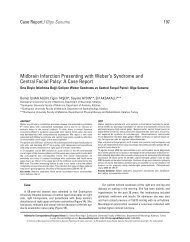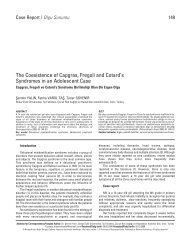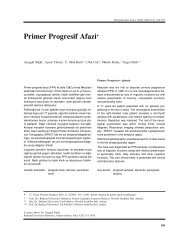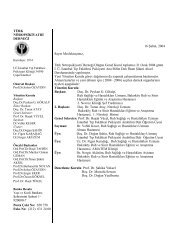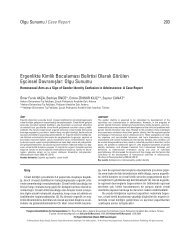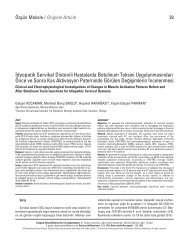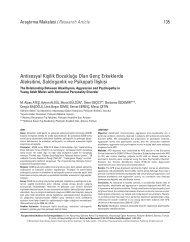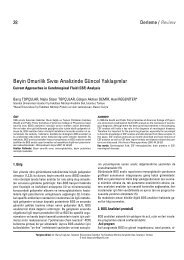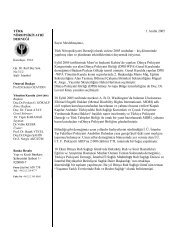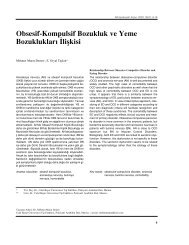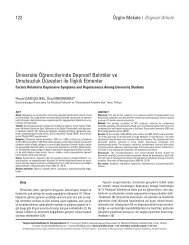New Delirium Rating Scale for ICU - Nöropsikiyatri ArÅivi Dergisi
New Delirium Rating Scale for ICU - Nöropsikiyatri ArÅivi Dergisi
New Delirium Rating Scale for ICU - Nöropsikiyatri ArÅivi Dergisi
You also want an ePaper? Increase the reach of your titles
YUMPU automatically turns print PDFs into web optimized ePapers that Google loves.
Archives of Neuropsychiatry 2010; 47: 36-9<br />
Nöropsikiyatri Arflivi 2010; 47: 36-9<br />
Ok et al.<br />
<strong>New</strong> <strong>Delirium</strong> <strong>Rating</strong> <strong>Scale</strong> <strong>for</strong> <strong>ICU</strong> 39<br />
Table 2. Demographic data and patients’ diseases<br />
Patients (n:30)<br />
Age, mean (SD) 48.6±17.24<br />
Gender (Male:Female) 24: 6<br />
Blood urine nitrogen (BUN), (mg/dl) (SD) 32.4±3.5<br />
Creatinin, (mg/dl) (SD) 0.8±0.2<br />
APACHE II score, mean (SD) 7.6±2.3<br />
Multiple trauma 14<br />
Abdominal surgery 12<br />
Gastrointestinal bleeding 4<br />
evaluation of delirium by the intensivist carries some difficulties.<br />
Trzepacz’s <strong>Delirium</strong> <strong>Rating</strong> scale evaluates attention, memory,<br />
orientation and cognitive abilities in one clause (19), there<strong>for</strong>e,<br />
assessing the symptoms through this scale should be complex<br />
<strong>for</strong> the intensivists, since they are not familiar with psychotic<br />
symptoms. On the other hand, NDRS is a well-structured scale<br />
that questions the cognitive abilities individually and<br />
intensivists could assess the patients easily by using these<br />
clear definitions and assessment of sleep-wake cycle, diurnal<br />
variation and lability of mood are the superiority of this tool over<br />
CAM-<strong>ICU</strong>.<br />
In conclusion, intensivists used NDRS, a detailed delirium<br />
assessing scale, easily and rated delirium so successfully that<br />
the inter-rater reliability <strong>for</strong> rating delirium between the<br />
intensivist and the psychiatrist was comparable.<br />
References<br />
1. Tucker GJ. The Diagnosis of <strong>Delirium</strong> and DSM-IV. Dement Geriatr<br />
Cogn Disord 1999; 10:359-63. [Abstract] / [PDF]<br />
2. Francis J, Martin D, Kapoor WN. A prospective study of delirium in<br />
hospitalized elderly. JAMA 1990; 263:1097-101. [Abstract] / [PDF]<br />
3. Inouye SK, Schlesinger MJ et al. <strong>Delirium</strong>: a symptom of how<br />
hospital care is failing older persons and a window to improve<br />
quality of hospital care. Am J Med 1999; 106:565-73. [Abstract] / [Full<br />
Text] / [PDF]<br />
4. O'Keeffe S, Lavan J. The prognostic significance of delirium in older<br />
hospital patients. J Am Geriatr Soc 1997; 45:174-8. [Abstract] / [Full<br />
Text]<br />
5. Metitieri T, Bianchetti A, Trabucchi M. <strong>Delirium</strong> as a predictor of<br />
survival in older patients with advanced cancer. Arch Intern Med<br />
2000; 160:2866-7. [Abstract] / [Full Text] / [PDF]<br />
6. Inouye SK, Bogardus ST, Charpentier PA et al. A multicomponent intervention<br />
to prevent delirium in hospitalized older patients. N Engl J<br />
Med 1999; 340:669-76. [Abstract] / [Full Text] / [PDF]<br />
7. Levkoff SE, Evans DA, Liptzin B et al. <strong>Delirium</strong>: the occurrence and<br />
persistence of symptoms among elderly hospitalized patients. Arch<br />
Intern Med 1992; 152:334-40. [Abstract] / [PDF]<br />
8. Bergeron N, Dubois MJ, Dumont M et al. Intensive Care <strong>Delirium</strong><br />
Screening Checklist: evaluation of a new screening tool. Intensive<br />
Care Med 2001; 27:859-64. [Abstract] / [Full Text] / [PDF]<br />
9. Ely EW, Siegel MD, Inouye S. <strong>Delirium</strong> in the intensive care unit: an<br />
under-recognized syndrome of organ dysfunction. Semin Respir Crit<br />
Care Med 2001; 22:115-26. [Abstract] / [Full Text] / [PDF]<br />
10. Ely E, Margolin R, May L et al. Evaluation of delirium in critically ill<br />
patients: validation of the Confusion Assessment Method <strong>for</strong> the<br />
Intensive Care Unit (CAM-<strong>ICU</strong>). Crit Care Med 2001; 29:1370-9.<br />
[Abstract]<br />
11. Bergeron N, Skrobik Y, Dubois MJ. <strong>Delirium</strong> in critically ill patients.<br />
Critical Care 2002; 6:181-2. [Abstract] / [Full Text] / [PDF]<br />
12. Hart RP, Levenson JL, Sessler CN et al. Validation of a cognitive test<br />
<strong>for</strong> delirium in medical <strong>ICU</strong> patients. Psychosomatics 1996; 37:533-46.<br />
[Abstract] / [PDF]<br />
13. Aydemir Ö, Noyan A, Gülseren S ve ark. Deliryum derecelendirme ölçe-<br />
¤inin gelifltirilmesi, güvenirli¤i ve geçerli¤i. 3 P <strong>Dergisi</strong> 1998; 6:21-7.<br />
14. Knaus WA, Wagner DP, Draper EA et al. APACHE II: a severity of<br />
disease classification system. Crit Care Med 1985; 13:818-29.<br />
[Abstract]<br />
15. Trzepacz PT. The <strong>Delirium</strong> <strong>Rating</strong> <strong>Scale</strong> (Its Use In Consultation-Liaison<br />
Research). Psychosomatics 1999; 40:193-204. [Abstract] / [Full Text] / [PDF]<br />
16. Ely E, Shintani A, Truman B et al. <strong>Delirium</strong> as a predictor of mortality<br />
in mechanically ventilated patients in the intensive care unit. JAMA<br />
2004; 291:1753-62. [Abstract] / [Full Text] / [PDF]<br />
17. Chevrolet JC, Jolliet P. Clinical review: Agitation and delirium in the<br />
critically ill significance and management. Critical Care 2007; 11:214.<br />
[Abstract] / [Full Text] / [PDF]<br />
18. Siegel M. Management of agitation in the intensive care unit.Clin<br />
Chest Med 2003; 24:713-25. [Abstract] / [Full Text] / [PDF]<br />
19. Trzepacz PT, Dew MA. Further analyses of the delirium rating scale.<br />
Gen Hosp Psychiatry 1995; 17:75-9. [Abstract] / [PDF]<br />
20. Pompei P, Foreman M, Cassel CK et al. Detecting delirium among<br />
hospitalized older patients. Arch Intern Med 1995; 155:301-7.<br />
[Abstract] / [PDF]<br />
21. Marcantonio ER, Juarez G, Goldman L et al. The relationship of<br />
postoperative delirium with psychoactive medications. JAMA 1994;<br />
272:1518-22. [Abstract] / [PDF]<br />
22. Pandharipande P, Jackson J, Ely E. <strong>Delirium</strong>: acute cognitive<br />
dysfunction in the critically ill. Curr Opin Crit Care 2005; 11:360-8.<br />
[Abstract]<br />
23. American Psychiatric Association (APA) Practice Guidelines <strong>for</strong> the<br />
Treatment Psychiatric Disorders. Compendium 2006, p. 79.<br />
24. De Jonghe B, Cook D, Griffith R et al. Adaptation to the intensive care<br />
environment (ATICE): development and validation of a new sedation<br />
assessment instrument. Crit Care Med 2003; 31:2344-54. [Abstract]<br />
25. Devlin J, Boleski G, Mlynarek M et al. Motor activity assessment scale:<br />
a valid and reliable sedation scale <strong>for</strong> use with mechanical ventilated<br />
patients in an adult surgical intensive care unit. Crit Care Med<br />
1999; 27:1271-5. [Abstract]<br />
26. Riker R, Picard J, Fraser G. Prospective evaluation of the Sedation-<br />
Agitation <strong>Scale</strong> (SAS) <strong>for</strong> adult critically ill patients. CritCare Med<br />
1999; 27:1325-9. [Abstract]<br />
27. Pisani M, Araujo K, Van Ness P et al. A research algorithm to improve<br />
detection of delirium in the intensive care unit. Crit Care 2006;<br />
10:R121-9. [Abstract] / [Full Text] / [PDF]


